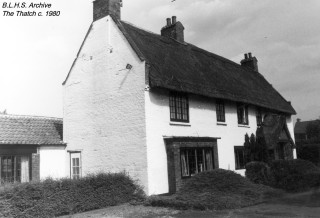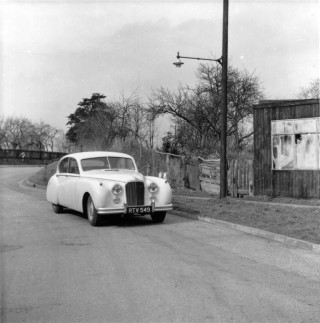Eddie Houghton-Ward's memories of Bottesford 1939 - 1980
A letter from 'Down-Under'
By Edward Houghton-Ward
I and my sisters, Heather Treacy and Valerie Brittain, lived in Bottesford from 1939 to about 1980, when my mother sold The Thatch and moved to Bingham. The Thatch is one of the oldest buildings in the village. I remember in the ’60s a person was researching the church, and said that they found more documented about The Thatch than the church, which as you know is very old. I recall that the deeds were about 18 inches thick and went back to about 1600, when the place was sold for 16 pounds. The building was converted from cottages into a single dwelling around 1920 I believe. Doctor Martin owned it then. It was quite a medical centre, with Dr Wright next door. While I lived there, a lady doctor had her surgery in the house opposite too. She was partly disabled and drove a Singer convertible [Dr Norah Woll – Editor].
Thatched roofs are rare, many of them it was said being burnt through steam engines giving off sparks. There was another down the west-end in about the forties – I believe the Hathaways lived there (there was also a chip-shop there too, in addition to the Queens Street chippie). The fireplace in the hall of The Thatch was constructed of bricks from the Roman villa nearby. I think it was north-west of the village near the river, though I never saw it. One of the fireplaces of the Thatch was rebuilt in the 1920’s by I think Doctor Martin, using Roman bricks. Unfortunately the new owner in 1980 didn’t know, and demolished it.
My mother mentioned that the family had some time previously owned a pub in Queen Street, though I have no further information about that. It must have been mid-nineteenth century. [This was probably the Marquis of Granby – Editor]
The house you featured [Claremont House – Editor] was next door to The Thatch. Thomas Rigby with his parents lived there in the 40’s, and I think the Wallaces moved in after them. The stable is now part of the house. We used to play at war games using a real gun, a sawn-off .22 (without ammo); we were all weapons trained from a young age, and were never allowed to point a gun at a person, even a toy one. There was another family, from the Belvoir Estates, the Armstrongs, whose son went to work at CERN, in Geneva, on nuclear reactors – he was most excited.
The Roberts family owned the block on the corner of Albert Street and this is where the blacksmith had his forge. Guy Lovatt was the local coal merchant with his horse-drawn coal cart. Mr Hare, who also lived in Albert Street, had a pony and trap which he drove down Barkestone lane to his land. I recall in about 1943 my grandfather (Joy Taylor’s grandfather- George Rowbottom) driving me with his horse, Don, and trap from Arnold to Bottesford through the lanes. This is one of my earliest memories, together with the comforting sound of ‘thousands’ of Lancaster and Wellington bombers droning overhead, and the less comfortable thump of land-mines aimed at the railway just over the fields. The church spire was the last to be hit by enemy fire (machine gun) during the second world war. I made a painting of Bottesford some thirty years ago, base on memories from about 1945, and it is now hanging on the wall of the lounge in Banora Point on the Australian east coast (just an hour’s drive north of Byron Bay- the most easterly point of Aus).
As regards rationing, the most I can remember is the ration book with your ID number in big letters across the top (mine was YMQC 61/4). Each week we were entitled to a 1/4 lb. of sweets, and this was highly treasured. The book was filled with tokens for meat, sugar, butter etc.
I helped Gerry Firth (of the Firth Stainless Steel company, with a farm down Barkestone Lane) driving his Ferguson tractor in 1950 and also doing the stooking of the corn (wheat); ‘Lawyer’ was his labourer, and quite a character. I also remember skating on the canal, church choir and Mr Carter. We turned ‘The Thatch’ into a restaurant (the original sign I made was still there on our visit in 1999). They were great times.
When we were about 15 a few of us being confirmed went along to the vicarage on a Sunday afternoon for classes. One day Mick Taylor (butcher) was not present. Canon Blackmore asked where he was and some wag replied “He’s killing pigs” (not good in those days of Sunday observance), and then told Mick it was me that said it!
The river Devon used to meander and had willow trees all along its banks. There was a sandy bank west of Taylor’s farm where it was very pleasant to swim and sunbathe. It was unbelievably beautiful. The council engineers, not understanding ecology or even hydrology later turned it into a concrete lined culvert. How dumb can one get? I believe they have since learned the error of their ways. Has the river been reinstated?
My dad was a garrison engineer during the Second World War (he had been injured at Ypres in the First World War) and drove a convertible (permanently, as the hood was rotten) Singer. After the war, he got his 1939 black SS (pre-Jaguar) CAT477 back on the road, later selling it for 250 pounds. Pop died of a nosocomial (hospital acquired) infection of golden staph in 1975. Interestingly, I’ve been doing some spare-time work on improving infection control with an American company, but nothing has come of it yet, and probably won’t given the American predilection for hype and top-heavy business (in my experience).
One small thing, as a young person, I remember the local greeting was “Ey oop surri”- this probably relates to Will’s constant reference to “Sirrah”, and everybody knows that Bottesford was the birthplace of the English language – well that’s my take on it anyway. I believe we are near the centre of its origin but the historians would know better. I base this on old books, Piers Ploughman, and Chaucer to some extent and it’s probably a load of b——s to use another local expression. Anyway it suits my purposes when justifying my expressions and dialect!
Banora Point is pretty good, now we are only five minutes from beaches, shops, dentists, doctors and ATMs. We moved here two years ago on completion of our law degrees, (cheaper to study law than hire a barrister when son Barnaby, 28, died in a ‘marine incident’ in November 2000 off Townsville). We had lived till then at Rosebank, about an hours drive south of Banora. Life there was idyllic on a small hobby-farm (2 acres) and 120 free-range chooks, (lots of snake stories) but we were half an hour away from everything and anything except woods. Rosebank has a small paper which you can see at www.villagejournal.org.au/ and this will give you some idea of the flavour of the place.
It is surprising that my generation is now the bearer of history. Don’t you have any 80 or 90 year-olds? Still, there must be a good hundred of us left, so we should be able to make a comprehensive history. Give my regards to Peter Topps, David Wright, Jeff Norris, the Lee boys, the Roberts brothers, Norma Taylor, and the many others.
I hope to be of assistance. As Michael Bradshaw says, it was such a lovely place to grow up in.
Eddie Houghton-Ward.
8 Banora Boulevard , BANORA POINT, NSW 2486, AUSTRALIA.
Tel/Fax (0)7 55 130 672.











Comments about this page
Eddie,
Can you give me any information about George Rowbottom who you have referred to as ‘Joy Taylor’s grandfather’. I do not recognise the name so any more information on this gentleman would be of interest to me. Thanks
Joy Taylor
Hi Joy, As you see, it’s been a long time twixt visits! I thought Grandpa Rowbottom’s name was George Sowerby, am I wrong? Sowerby should know, I’ll ask him. Love to you all. Ed
Add a comment about this page